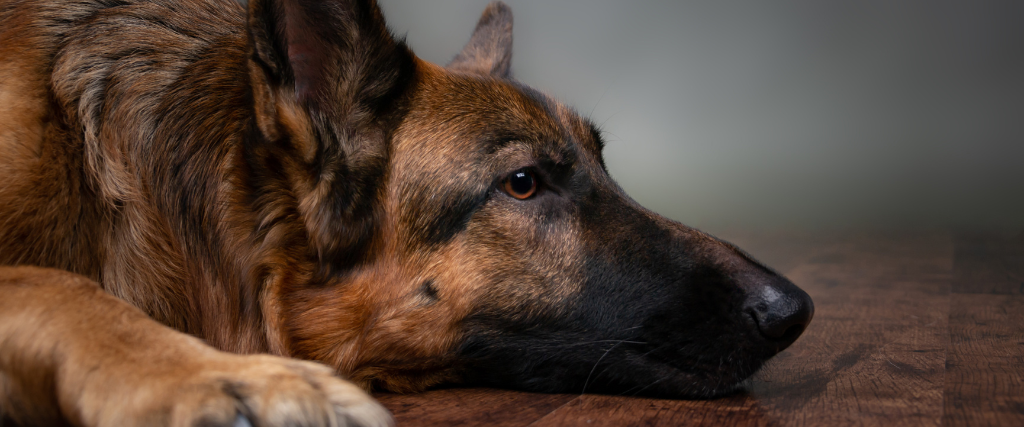Anyone who has been blessed with a pet that has made it into the golden years of life knows that as time progresses, things can become more difficult for our beloved furry friends. One thing that some dog owners may see with their dog is a disease called degenerative myelopathy.
What Is Degenerative Myelopathy?
Degenerative myelopathy is a spinal cord disorder that is slow to progress. It looks very similar to Lou Gehrig’s disease in humans. Degenerative myelopathy commonly affects older dogs and for a long time, it was thought that only German Shepherd dogs were affected by it. We now know it can affect any breed of dog. It is caused by a genetic mutation in the affected dog’s DNA. This genetic mutation inhibits neurons in the spinal cord from transmitting signals from the dog’s brain to the rest of the body and vice versa.

What Are Symptoms Of Degenerative Myelopathy?
Degenerative myelopathy usually starts with the affected dog being uncoordinated in the hind legs (ataxia); dragging its hind legs which causes these dogs to have worn toenails and general hind end weakness. Over the course of months to sometimes years, these symptoms will progress. Owners may see their dog knuckling over on their hind paws (weight barring on the tops of the paws instead of the bottom), having difficulty walking without support, and difficulty supporting weight on their hind legs. These signs eventually progress to loss of use of the hind legs and possible weakness in the front legs. As horrible as all of this sounds, degenerative myelopathy is not painful. That being said, dogs that suffer from degenerative myelopathy may become sore from overuse of other areas of their body while trying to compensate for their hind end weakness.
In the perfect world, to “correctly” diagnose degenerative myelopathy an owner would take their dog to a neurologist, have their dog’s spinal fluid analyzed, and have an MRI done to rule out other possible causes of the clinical signs mentioned above. In reality, most owners can’t afford the expensive diagnostics mentioned, and most general practitioners can confidently diagnose degenerative myelopathy with a thorough physical and neurological exam.
Treatment Options For Different Cases
Unfortunately, there is no treatment for degenerative myelopathy and the long-term prognosis is poor. Most owners are lucky if they get a year with their dog after it’s been diagnosed. The quality of life for these dogs can be maintained with good nursing care. This means keeping sores that may occur on hind paws or limbs clean, physical therapy, acupuncture, and even wheelchairs. There is also a physical toll that takes place on the owner since dogs affected with this disease need a lot of lifting and support when moving.
Over the past year, I have managed three dogs with degenerative myelopathy in three different ways. One dog was a Bernese Mountain Dog. The first time I saw her for degenerative myelopathy was when her owner noticed that she was walking with her back paws knuckled over which was causing abrasions on her hind paws. We treated her with nursing care, kept her moving, and gave her pain medication. Almost a year after her initial diagnosis of degenerative myelopathy, she lost control of her hind legs and we sent her over the rainbow bridge. The second dog I treated was a 14-year-old Old English Sheepdog. When I first started seeing him, he only had arthritis in his hind end. Eventually, his owner started noticing that his dog was ataxic in the hind end and he was diagnosed with degenerative myelopathy. This patient was already on pain medication for his arthritis. The owner opted to treat his dog with laser therapy. I can’t say for sure if the laser therapy was helping this patient more with his arthritis or his degenerative myelopathy. We found that if he received laser therapy every other week his clinical signs seemed less severe and he was able to move better in general. Unfortunately, after about nine months of treatment, this patient’s quality of life began to deteriorate and he was also sent over the rainbow bridge.

My third patient was most recently diagnosed. This dog is a 12-year-old mixed breed that was diagnosed by his regular veterinarian. The owner sought me out for acupuncture treatment. Overall this patient is in great shape and there are no obvious signs of arthritis or back pain on the physical exam. He has been receiving acupuncture for about three months and both the owner and I can see a big difference. He comes every other week for his treatment and usually leaves with a spring in his step. The owner has also noticed that he’s more willing to go for walks. Time will tell how well acupuncture will manage his degenerative myelopathy. The important thing to remember with degenerative myelopathy is that the condition itself is not painful to the dog, but is more “painful” for the owner to watch. If you have a dog with degenerative myelopathy it is important to remember that it’s about the quality of your dog’s life and not the quantity of the days. Even though there is no cure for degenerative myelopathy, this disease can be managed for a while. It takes dedication from the owner and an understanding that time is limited.

